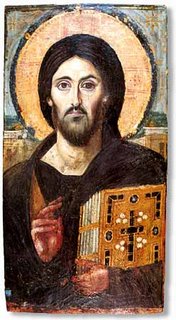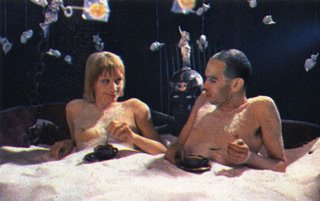Walerian Borowczyk's short film Escargot de Venus (1975) is an interesting work for its associations above all. One can download it and several other Borowczyk shorts from Ubuweb, where the description reads, "This is the portrait of painter Bona Tibertelli De Pisis wife of writer Pieyre De Mandiargues while working in her atelier, together with fragments of her graphic works inspired by one of Remy de Gourmont's writings." Gourmont (whose work I don't know) was something of a controversial libertine-hermit, a Symbolist, and an influential figure of Parisian letters in the late 19th and early 20th century. Pieyre De Mandiargues was among other things the writer behind Borowczyk's Cérèmonie d’amour (Love Rites), which was made in 1988, as well as the novel upon which La Marge (1974) was based. I like the idea of an artist building out his lineage, his network, his "tree of influences," and through Bona & Mandiargues Borowczyk has found one way (he has others) of reaching back into the extended fin-de-siècle for a figure like Gourmont, as well as the Surrealist lineage and its arguable forerunners of weird/dark literature (Mirbeau, Huysmans--writers whose work I've merely scanned in translation, no more, I humbly add). It is probably too great a stretch to group Surrealism in with the Symbolist moment in European culture, but I think Borowczyk focused on not a grouping of years so much as the texture of a broad historical moment before Europe's global "decline," that generation or two when the World Wars were fought, when the last great European empires (seemingly) fell, when the United States and the Soviet Union ascended into the roles of superpowers, when the economy and communications (media) reached towards a certain type of speed and global reach that nullified something of 'old handmade mysteries' (crafts and trinkets--but also mysteries of sex). On one level Borowczyk uses the whole filmic apparatus as a way of rescuing a shred of disappearing object-aura (and he'll treat his characters as "objects" too) in a mass-produced era. Benjamin saw photography & cinema as signifying the cultural eradication of the artwork's aura. Complementarily, Borowczyk saw cinema as the damned-if-you-don't technology which would paradoxically help keep discourse on these old objects alive.
(When it came to sex & culture, I might propose--not that I've even convinced myself yet--that Borowczyk was cinema's great oblique chronicler of the destructive nature of the twentieth century, while Makavejev was--for a while at least--its great ambitious problem solver.)

(Above: Sixth century Byzantine icon of Christ Pantokrator.)
Take the example of icons--if for no other reason (first) than to savor the idea of a hypothetical Borowczyk version of Andrei Rublev. I would venture to say that what marks Boro's entire aesthetic sense, as far as "the aura," would be completely neutral in terms of the fierce historical debates over icons--neither iconodule or iconoclast, I suspect he would neither venerate nor fear the power of the image. He believes in neither option because he believes in no power to glorify or offend, or so I infer from his work. What fascinates him is the power of the image or the object to spark debate, to spark devotion/revulsion, to draw affection, to symbolize, to be the focal point for intense psychic energies, to cause one to turn away. The effect of 'objects' (open to projection/interpretation if not exactly blank), discrete and special, upon human behavior is one of the great subjects of Borowczyk's treatment.
Earlier, I suggested that Joe Dallessandro's character's infidelity in La Marge is a function of the things around him, his environment--simply put, country vs. city. Above, however, it may not be the City and the Country as such, but the objecthood of Wife and Whore, in their separate and respective settings, who draw out different behaviors. The rumblings of the twentieth century in the time just before it truly "announced" itself, destroying something of the 19th century and its preceding age(s), are the source of artistic rivers such as Surrealism, and it is this historical-cultural-artistic reaction that Borowczyk (past the Surrealist moment, past the Symbolist moment, past the Arts & Crafts movement) seeks to recapture, casting his art back there like a fisherman casting a net.
On the other hand, Makevejev, takes the signs of this New Age and makes them unfamiliar, weird, alienating, decrepit, maybe comic ...

... and wonders if we can reclaim something, or liberate what we never had claim to, through more radical experiences, ineffable libidinal experiences, whose specialness is not old & lost--perhaps hung on to by threads (Borowczyk)--but altogether new.


4 comments:
Zach, you may already know of it, but just in case you don't, there's a gallery of some of Borowczyk's artwork found here. Some of these (check out the ones on page 12) express a classically Borowczykian tension between object and body.
It's great to see you continuing to write such fascinating posts on this extraordinary filmmaker. I really like the Makavejev contrast!
Mubarak, I've seen that gallery but haven't looked at the images in quite a while. Maybe I'll try to write a post on them soon? (Or maybe all Borowczyk-fan bloggers should?)
I've got to get ahold quick of some more Makavejev, I've still to see Love Affair, Innocence Unprotected, several others ...
One can write essays based on your posts
One can write essays based on your posts
Post a Comment